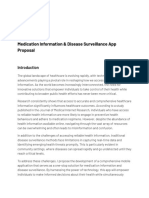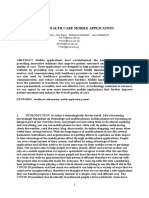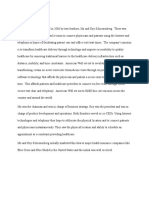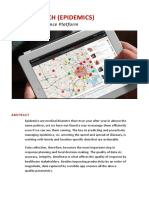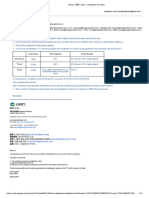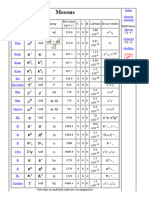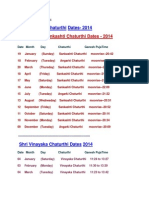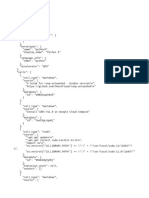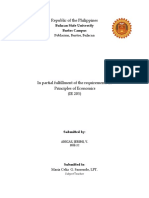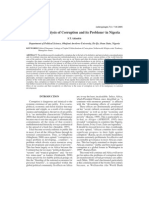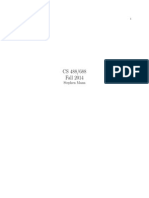Emily Chahalis
Eliza Broadbent
Paola Donoso
Lexi Sayer
Team Innovation Pitch
Fall 2020
Phase 1: Clarify
The main observation tool used by our group to identify pain points was Journey
Mapping. This tool allowed us to identify a situation in which an overworked and tired mother is
unable to keep track of vaccinations for her children, being appropriately educated about
screenings for her husband and herself, as well as education for the management of her mother’s
health complications. As we used the Journey Mapping tool, we identified several pain points
which included remembering the appropriate age for a child’s vaccination, remembering the
appropriate age and frequency for certain screenings (mammogram, colonoscopy, etc.), as well
as not knowing where to find accurate information about disease management. We also used
aspects of the Look-Ask-Try observation tool. The main points used from this tool were “ask”
and “try.” Through this phase, we were able to be open to suggestions and to continually ask
“why.” This helped confirm pain points that had previously been discussed. Similar to the
Journey Mapping tool, we were able to simulate what the best option would be for addressing
these pain points through the “try” portion of this tool. This included the use of an app to educate
about recommended screenings or being educated by physicians and healthcare workers at
appointments.
Identifying these pain points and using these tools helped us to make insightful
observations such as determining the easiest way to address these three pain points. After talking
through several ideas, the idea for an app seemed to be the best option. There were several “aha”
moments as we continued the Journey Mapping and Look-Ask-Try process and identified pain
points when an app is not user-friendly, or does not contain all of the necessary information (in
this case, health information for all family members) in one place. This also led to the
identification of opportunities for solutions. Solutions included the use of a format similar to the
BYU app. This would allow users to add the functions they deem necessary and allow the app to
be tailored to each unique family. Other solutions included the ability to add family members and
pre-existing conditions each member might have. An option for notifications would also be
included to remind users of recommended vaccinations that may be coming up, as well as the
recommended screenings.
Phase 2: Ideate
After our initial meeting for phase one, we planned to meet again later and each bring
several potential solutions. We created a productive space for brainstorming in this second
meeting by establishing a clear focus at the beginning and structuring the meeting to end with a
vote on which option we would pursue. In line with the Six Thinking Hats tool, we began with a
“process” mentality, establishing how ideas would be shared (one by one, with a discussion at
the end) and moved to the “facts” mentality in talking about the assignment and getting on the
same page about the purpose of the project as discussed in class. From there we shifted into the
creativity lens, with each group member expressing one or more ideas they had developed since
last meeting. These solutions were wide-ranging, from having pill dispensers required by
�insurance in order to prevent opioid overdose to setting insurance rates based on the individual's
use of activity-monitoring bracelets. From there, we put on the “feelings” hat to get an initial
response to these ideas; here, the idea that was the most emotionally salient for us was an app
that would assist busy and overtaxed mothers. We then moved interchangeably between the
benefits and cautions mindset as we further fleshed out this solution. To this rough idea we
applied the ideation tool of task unification. We discussed how many doctor’s offices have
moved to an online check-in and that some hospital systems, such as Intermountain Healthcare
and Mayo Clinic, have apps for their organizations. This existing resource could be expanded to
allow patients to both learn about their upcoming visits and keep track of the screenings needed
by both themselves and their family members.
Phase 3: Develop
The My Family, My Health app will provide a one-stop service center for managing
preventative health activities for the whole family. There are many logistical barriers for
individuals and families seeking to remain up to date on recommended preventative health
services such as vaccinations, health screenings, and wellness check-ups. Individuals may not
participate in these important services due to a lack of education about the purpose and
importance of the service, lack of knowledge about the appropriate timing of the service, or lack
of information regarding where and how a service can be accessed. My Family, My Health will
address these and other barriers by providing a customizable health portal with preventative
health service education, tracking, and accessibility information components for each member of
the family. Within the app, an individual can customize a family health center by selecting
relevant functions (e.g., the vaccination tracker, screening tracker, wellness check-up tracker,
preventative health services encyclopedia, appointment scheduler, or community resource
guide). After setting up the family portal, the individual may create personal profiles for each
member of the family with information–such as age, location, pre-existing health conditions, and
preventative service access history–to help the app create individually tailored recommendations
and notifications about preventative health services.
The design of the app will focus on addressing relevant social determinants of health,
especially health literacy. Health literacy involves the ability to successfully navigate the medical
system. Individuals are often not able to utilize preventative health services because they lack
knowledge about services’ purpose, timing, and process. This app will provide easily accessible
information to educate about preventative health services and reminders to aid in scheduling of
appointments for family members of all ages. Language is also an important part of health
system literacy. Because the Hispanic population is a prevalent minority group in the United
States, the app will be developed in both English and Spanish.
Building off of this, our value proposition is the following: My Family, My Health
recognizes and addresses barriers to accessing important preventative health services across the
lifespan by providing a one-stop preventative health hub with resources to improve preventative
health service knowledge, tracking, and accessibility for each member of the family.
In order to bring the My Family, My Health concept to life, the team must create and
maintain a user-friendly app. This app can be modeled after other health-portal-type applications
with the option of creating multiple user profiles within one family portal. Personalized
recommendations and notifications can be generated from pre-set algorithms based on the
demographic and health factors provided by users. For instance, the app will recommend and
notify the family of upcoming vaccine requirements by running a child’s age and vaccine record
�through an algorithm set with the recommended vaccine schedule. Such a system would require
technical assistance in creating these algorithms and keeping them up to date with changing
preventative health recommendations.
Hospitals and health care organizations will buy a subscription to our application every
year, and they will distribute it among their patients. The health care organization will provide
each patient with a specific code number that will allow them to register in the app for free. The
app designers will work with each organization to verify that the patient can access her personal
information regarding vaccines, screenings, comorbidities, and medication.
Hospitals and health care organizations will benefit from purchasing this app since fewer
staff will be necessary to notify each patient about their upcoming vaccines and screenings.
Another advantage of the app is the capability to provide drug information for each patient. This
saves nurses 15-20 minutes as it allows nurses to spend less time explaining to patients the
correct dose, route, and frequency of each drug. This function of the app is called “prescription,”
and each patient will have access to their prescriptions and receive notifications of when to take
their medications. Health institutions will also have the opportunity to advertise campaigns,
programs, and new services in the application for an extra monetary value.
In developing this app for implementation, the first step will be to hire bilingual
informatic designers to create an application prototype. The second step will be presenting the
project to hospitals and health organizations to form partnerships and alliances. The third step
will consist of pilot testing the app to improve and refine it according to the critical feedback that
will be provided by patients, health providers, and health administrators. The fourth step will
focus on implementing the application in the designated health organizations. In collaboration
with health professionals, the design team will update the application according to new guides,
regulations, and protocols at state and federal levels. After one year, the evaluation team will
analyze the outcomes according to the statistics that will be recorded by our epidemiological
team.








